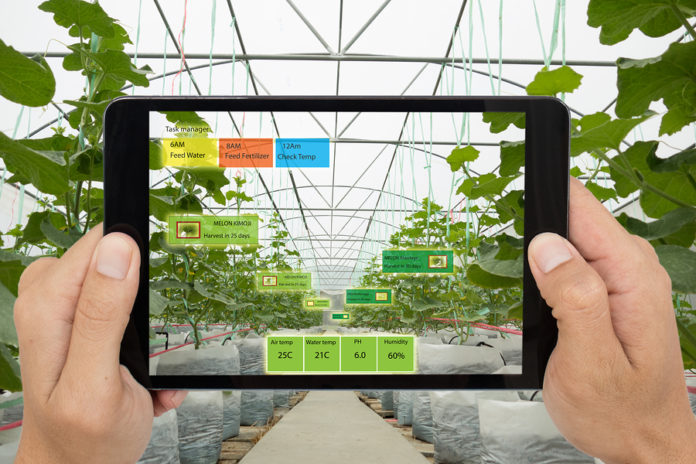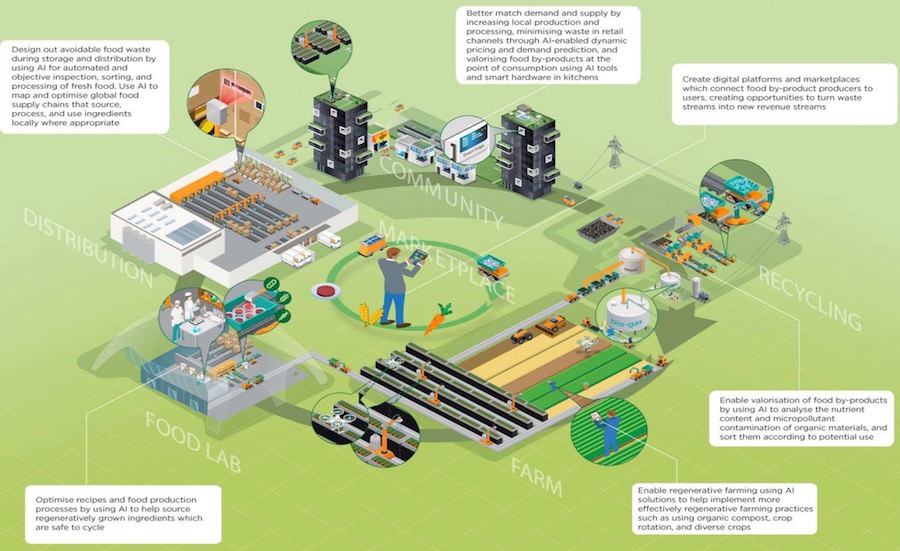
“The potential value unlocked by AI in helping design out waste in a circular economy for food is up to USD 127 billion a year in 2030,” according to Artificial Intelligence and the Circular Economy from the Ellen Macarthur Foundation. Opportunities come at all points in the food system: farming, processing, logistics, and consumption. For example, image recognition can identify when fruit is ready to pick, algorithms can better match food supply and demand, and AI can improve the process of turning food by-products into new useful products.
What is a circular economy?
The traditional linear economy involves making, using, and disposing of products. In contrast, a circular economy operates based on three principles:
- Design out waste and pollution. The goal is for today’s products to become tomorrow’s resources, avoiding environmental harm.
- Keep products and materials in use. A circular economy supports activities that increase product use and reuse.
- Regenerate natural systems. For example, in the food industry, this principle includes using agricultural practices that go beyond not degrading soil to rebuilding soil health.
“In a vision for a circular food system, food production improves rather than degrades the environment and people have access to healthy and nutritious food,” according to the report.
Factors that play into that vision include:
- Regenerative agriculture improves the overall health of local ecosystems and people.
- Food is produced globally, regionally, and locally, according to where each food grows best.
- Food design and marketing supports making healthier food part of people’s daily diets.
- Food by-products become value streams rather than waste streams.
AI and the circular food economy
AI can help build a circular economy in three key ways:
- Improve and speed up developing new products, components, and materials. Design processes that use iterative machine-learning allow rapid prototyping and testing.
- Expand the competitive strength of circular economy business models. AI can combine real-time and historical data from products and users. Using this information for predicting demand and pricing, smart inventory management, and predictive maintenance can help increase circulation of products and use of assets.
- Improve the processes to sort and disassemble products, remanufacture components, and recycle materials. This can help build and enhance the reverse logistics infrastructure needed to make the use of products and materials circular.
The paper cites the following examples of companies already using AI in ways that support the development of a circular food economy:
- In production and processing, TOMRA food sorting solutions identify non-uniform produce and sort it based on its best use. AI algorithms analyze images and data from cameras, near infrared spectroscopy, x-rays, and lasers.
- In distribution and storage, the Food Team at Google, in collaboration with X, is looking at how visual imagery techniques could help accelerate the food inspection process. This could improve food supply chain efficiency, reduce waste, and help retailers plan more accurately.
- In preparation and consumption, Wasteless uses AI-enabled tracking and dynamic pricing based on expiration dates to help retailers sell food before it goes bad. Leanpath and Winnow offer tools that capture, track, and categorize data on food waste in institutions and restaurants.
- In the area of turning food waste and leftovers into valuable products, the Food Program at Google and X are exploring food waste intelligence technologies. For example, smart hardware could automate and capture data about pre-consumer food waste, and AI tools could then suggest potential recipes using leftovers.
- In food design, several companies developing plant-based meat use AI algorithms to help identify and create plant-based alternatives to animal proteins. Similarly, New Age Meats uses AI to model and determine the best conditions for producing lab-grown meat.
As consumer demand for convenient, easy-to-prepare food increases, so does the opportunity to design and process food in a circular way. According to the report, “By using AI as a tool to help source regeneratively grown ingredients, replace animal protein ingredients with plant-based proteins, reduce processing waste, and avoid unsafe additives, food innovators and designers can make it easier for people to access healthy food products.”









